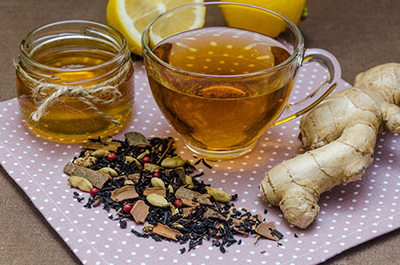Ingredients:
- 1 large garlic clove, crushed
- ½ tsp. grated fresh ginger root
- Juice of ½ a lemon
- ½ -1 tsp. of honey
- One generous pinch of cayenne pepper.
Directions:
Place all food ingredients into a large cup or mug.
Fill with boiling water, stir well.
Drink all, including ginger & garlic particles.

Health Benefits of Ingredients
Asthma is helped by Ginger:
For ASTHMA, ginger has been found to help relax and open airways, and reduce wheezing, tight chest, and shortness of breath. A study presented at the American Thoracic Society International Conference from researchers at Columbia University show that purified components of the spicy root also may have properties that help asthma patients breathe more easily. Increased airway constriction may be a result of increased contractile signaling, impaired relaxation signaling, or a combination of both in the airway smooth muscle (ASM) tissues. Bronchodilators are the first-line therapy during acute asthma attacks to reverse airway obstruction, but researchers are aware of the need for new therapies that reduce dangerous side-effects especially with long-term use. Researchers demonstrated that purified components of ginger: 6-gingerol, 8-gingerol (zingerones), or 6-shogaol worked synergistically with a beta-agonist asthma medication isoproterenol to relax airway smooth muscle (ASM) tissues.1
It is believed that these compounds have particular anti-inflammatory and analgesic properties similar to non-steroidal anti-inflammatory drugs (NSAIDs). Because ginger enhances bronchodilation, it is a very safe adjunct to acutely relax airways while also augmenting traditional medical therapies.
Recommendation: ½ tsp. of ginger root or ⅛-¼ powdered ginger 1-2 times daily.
References:
- Townsend EA, Zhang Y, Xu C, Wakita R, Emala CW. Active Components of Ginger Potentiate β-Agonist–Induced Relaxation of Airway Smooth Muscle by Modulating Cytoskeletal Regulatory Proteins. American Journal of Respiratory Cell and Molecular Biology. 2014;50(1):115-124.
Frequent Colds & Immune Support are helped by Garlic:
For FREQUENT COLDS & FLU, garlic is a potent immune booster that works in several ways to disable viruses and bacteria, and to stimulate white blood cells to attack invading microbes. It is an excellent remedy for an acute cold, and can help reduce the severity and cut the duration of a cold or flu.
Whole garlic contains a compound called alliin. When garlic is crushed or chewed, this compound becomes allicin, the main active ingredient in garlic. Allicin (diallylthiosulfinate) is a defense molecule from garlic with a broad range of biological activities that in a dose-dependent manner can inhibit the proliferation of both bacteria and fungi or kill those cells outright. These compounds have been shown to boost the disease-fighting response of white blood cells when they encounter the viruses that cause the common cold or flu. Garlic enhances the functioning of the immune system by stimulating macrophages, lymphocytes, natural killer (NK) cells, dendritic cells, and eosinophils, by mechanisms including modulation of cytokine secretion, immunoglobulin production, phagocytosis, and macrophage activation. A randomized, double-blind, placebo-controlled parallel intervention study recruited 120 healthy subjects to determine the effect of aged garlic extract supplementation on immune cell proliferation and cold and flu symptoms. Results suggest that supplementation with aged garlic extract may enhance immune cell function and that this may be responsible, in part, for reduced severity of colds and flu.1
Over the long term, garlic has shown promise as a treatment for preventing colds and the flu. One study gave 146 healthy volunteers either garlic supplements or a placebo for three months. The garlic group had a 63% lower risk of getting a cold, and their colds were also 70% shorter.2
Recommendation: 1 clove of garlic 2-3 times per day.
References:
- Nantz MP, Rowe CA, Muller CE, Creasy RA, Stanilka JM, Percival SS. Supplementation with aged garlic extract improves both NK and γδ-T cell function and reduces the severity of cold and flu symptoms: a randomized, double-blind, placebo-controlled nutrition intervention. Clin Nutr. 2012 Jun;31(3):337-44.
- Josling P. Preventing the common cold with a garlic supplement: a double-blind, placebo-controlled survey. Adv Ther. 2001 Jul-Aug;18(4):189-93.
High Blood Pressure is helped by Cayenne:
For HIGH BLOOD PRESSURE, capsaicin, the primary ingredient in cayenne that gives the peppers their heat also opens up blood vessels and increases blood flow naturally lowering blood pressure. One of the most intriguing studies of long-term dietary consumption of capsaicin showed a definitive link to reduced blood pressure in genetically hypertensive rats.1 Those effects depend on the chronic activation of something called the transient receptor potential vanilloid 1 (TRPV1) channel found in the lining of blood vessels. Activation of the channel leads to an increase in production of nitric oxide, a gaseous molecule known to protect blood vessels against inflammation and dysfunction.
Although there have been several studies looking at acute of short-term exposure to capsaicin, this study is the first to look at long-term effects based on the researcher’s own observations of human dietary habit in his native China.
Blood pressure measures the force against the artery walls as your blood is circulated through your body. Many things can affect the numbers, including heredity, illness, nutrition, and hormones. Another study published in 2003 found that capsaicin affects sensory nerves that work with neuro-hormonal systems to help lower blood pressure.2 More research needs to be done in human subjects to determine definitive associations between capsaicin and blood pressure, so consult your health care provider before using capsaicin for your condition.
Recommendation: ⅛ tsp. powdered cayenne daily, or to taste.
References:
- Dachun Yang, Zhidan Luo, Shuangtao Ma, Wing Tak Wong, Liqun Ma, Jian Zhong, Hongbo He, Zhigang Zhao, Tingbing Cao, Zhencheng Yan, Daoyan Liu, William J. Arendshorst, Yu Huang, Martin Tepel, Zhiming Zhu. Activation of TRPV1 by Dietary Capsaicin Improves Endothelium-Dependent Vasorelaxation and Prevents Hypertension. Cell Metabolism, 2010; 12 (2): 130-141.
- Vaishnava, P.; Wang, D.H. Capsaicin Sensitive-Sensory Nerves and Blood Pressure Regulation. Current Medicinal Chemistry – Cardiovascular & Hematological Agents, Volume 1, Number 2, June 2003, pp. 177-188(12).